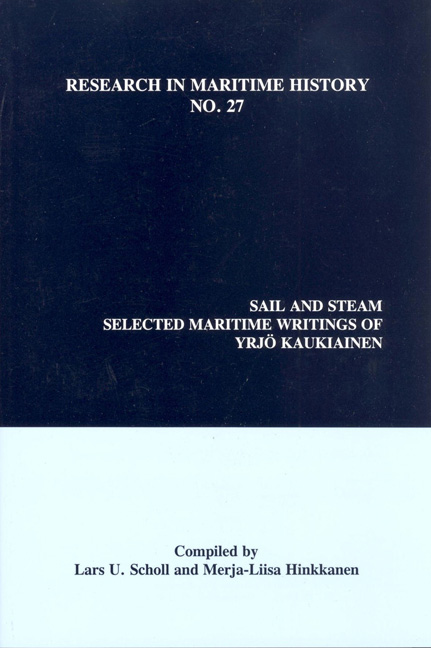Book contents
- Frontmatter
- Frontispiece
- Table of Contents
- Acknowledgements
- “Yrjö Kaukiainen: A Tribute on the Occasion of his Forthcoming Retirement as Professor of Maritime History at the University of Helsinki”
- “Yrjö Kaukiainen: A Man of the Sea”
- “Yrjö Kaukiainen and the Development of Maritime Economic History”
- “Finnish Sailors, 1750-1870”
- “Finnish and International Maritime Labour in the Age of Sail: Was There a Market?”
- “Five Years before the Mast: Observations on the Conditions of Maritime Labour in Finland and Elsewhere”
- “The Maritime Labour Market: Skill and Experience as Factors of Demand and Supply”
- “Owners and Masters: Management and Managerial Skills in the Finnish Ocean-Going Merchant Fleet, c. 1840-1880”
- “From Low-Cost to High-Cost Shipping: Finnish Maritime Labour Costs after the Second World War”
- “The Modernization of Finnish Coastal Shipping and Railway Competition c. 1830-1913”
- “British Timber Imports and Finnish Shipping 1860-1910”
- “Baltic Timber-Trade under Sail: An Example of the Persistence of Old Techniques”
- “Coal and Canvas: Aspects of the Competition between Steam and Sail, c. 1870-1914”
- “Dutch Shipping and the Swedish Navigation Act (1724). A Case Study”
- “Seamen Ashore: Port Visits of Late Nineteenth-Century Finnish Sailors”
- “Wreck-plundering by East Finnish Coastal People - Criminal Tradition or Popular Culture?”
- “From Days and Knots to Pounds and Dollars: Some Problems in the Study of the Economics of Late Nineteenth Century Merchant Shipping”
- “Tons and Tonnages: Ship Measurement and Shipping Statistics, c. 1870-1980”
- “International Freight Markets in the 1830s and 1840s: The Experience of a Major Finnish Shipowner”
- “Shrinking the World: Improvements in the Speed of Information Transmission, c. 1820-1870”
- “Yrjö Kaukiainen: A Maritime Bibliography”
“Coal and Canvas: Aspects of the Competition between Steam and Sail, c. 1870-1914”
- Frontmatter
- Frontispiece
- Table of Contents
- Acknowledgements
- “Yrjö Kaukiainen: A Tribute on the Occasion of his Forthcoming Retirement as Professor of Maritime History at the University of Helsinki”
- “Yrjö Kaukiainen: A Man of the Sea”
- “Yrjö Kaukiainen and the Development of Maritime Economic History”
- “Finnish Sailors, 1750-1870”
- “Finnish and International Maritime Labour in the Age of Sail: Was There a Market?”
- “Five Years before the Mast: Observations on the Conditions of Maritime Labour in Finland and Elsewhere”
- “The Maritime Labour Market: Skill and Experience as Factors of Demand and Supply”
- “Owners and Masters: Management and Managerial Skills in the Finnish Ocean-Going Merchant Fleet, c. 1840-1880”
- “From Low-Cost to High-Cost Shipping: Finnish Maritime Labour Costs after the Second World War”
- “The Modernization of Finnish Coastal Shipping and Railway Competition c. 1830-1913”
- “British Timber Imports and Finnish Shipping 1860-1910”
- “Baltic Timber-Trade under Sail: An Example of the Persistence of Old Techniques”
- “Coal and Canvas: Aspects of the Competition between Steam and Sail, c. 1870-1914”
- “Dutch Shipping and the Swedish Navigation Act (1724). A Case Study”
- “Seamen Ashore: Port Visits of Late Nineteenth-Century Finnish Sailors”
- “Wreck-plundering by East Finnish Coastal People - Criminal Tradition or Popular Culture?”
- “From Days and Knots to Pounds and Dollars: Some Problems in the Study of the Economics of Late Nineteenth Century Merchant Shipping”
- “Tons and Tonnages: Ship Measurement and Shipping Statistics, c. 1870-1980”
- “International Freight Markets in the 1830s and 1840s: The Experience of a Major Finnish Shipowner”
- “Shrinking the World: Improvements in the Speed of Information Transmission, c. 1820-1870”
- “Yrjö Kaukiainen: A Maritime Bibliography”
Summary
The transition from sail to steam has been recounted dozens of times and it seems unlikely that any great secrets remain to be revealed. Authors of standard textbooks present the process as a simple application of technology and devote most of their attention to discussions of the pioneering achievements in engineering that made it possible. On the other hand, several studies have confirmed that the diffusion of steam was gradual and that the pace was determined largely by mundane economic variables. Perhaps the most obvious characteristic of this transformation was its great spatial diversity. Not only did the timing of technical adaptation differ widely on different routes and commodity trades but also the economic gains of steam were disparate in various countries, depending above all on national wage levels and capital costs. It seems that in this respect the diffusion was more complicated than has been acknowledged generally and that a few relevant details can still be added to the larger picture.
Technical development was, of course, the prime reason for change, at least in the sense that steam gradually forced sailing vessels into more peripheral trades. Economics, however, effectively limited its advance because steamers, needing to pay for their fuel while windjammers exploited a free good (the wind), incurred higher unit costs. These had to be compensated by higher revenues. At first this was only possible on relatively short routes characterized by high and sustained demand for transport. Moreover, since steamers also incurred indirect costs by having to utilize valuable cargo space to carry this fuel, unit costs tended to be higher on long than short voyages. According to C. Knick Harley, steam costs per million cargo ton-miles varied in the early 1870s from £100 for 1000- mile journeys, to £111 for 5000-mile passages and £114 for 10,000-mile trips.
The development of compound and triple-expansion engines as well as innovations in boiler technology gradually improved fuel economy and lowered costs. Accordingly, steamers were increasingly able to compete successfully on long-distance voyages. As far as bulk cargo was concerned, this process took about a quarter-century. In 1865, the longest route on which steam was competitive was the Mediterranean fruit trade, a distance of roughly 3000 miles from Europe.
- Type
- Chapter
- Information
- Sail and SteamSelected Maritime Writings of Yrjö Kaukiainen, pp. 113 - 128Publisher: Liverpool University PressPrint publication year: 2004



